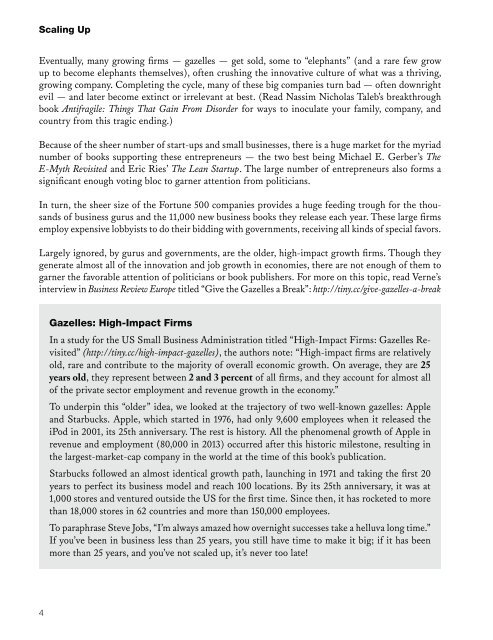Scaling-Up-Overview
Create successful ePaper yourself
Turn your PDF publications into a flip-book with our unique Google optimized e-Paper software.
<strong>Scaling</strong> <strong>Up</strong><br />
Eventually, many growing firms — gazelles — get sold, some to “elephants” (and a rare few grow<br />
up to become elephants themselves), often crushing the innovative culture of what was a thriving,<br />
growing company. Completing the cycle, many of these big companies turn bad — often downright<br />
evil — and later become extinct or irrelevant at best. (Read Nassim Nicholas Taleb’s breakthrough<br />
book Antifragile: Things That Gain From Disorder for ways to inoculate your family, company, and<br />
country from this tragic ending.)<br />
Because of the sheer number of start-ups and small businesses, there is a huge market for the myriad<br />
number of books supporting these entrepreneurs — the two best being Michael E. Gerber’s The<br />
E-Myth Revisited and Eric Ries’ The Lean Startup. The large number of entrepreneurs also forms a<br />
significant enough voting bloc to garner attention from politicians.<br />
In turn, the sheer size of the Fortune 500 companies provides a huge feeding trough for the thousands<br />
of business gurus and the 11,000 new business books they release each year. These large firms<br />
employ expensive lobbyists to do their bidding with governments, receiving all kinds of special favors.<br />
Largely ignored, by gurus and governments, are the older, high-impact growth firms. Though they<br />
generate almost all of the innovation and job growth in economies, there are not enough of them to<br />
garner the favorable attention of politicians or book publishers. For more on this topic, read Verne’s<br />
interview in Business Review Europe titled “Give the Gazelles a Break”: http://tiny.cc/give-gazelles-a-break<br />
Gazelles: High-Impact Firms<br />
In a study for the US Small Business Administration titled “High-Impact Firms: Gazelles Revisited”<br />
(http://tiny.cc/high-impact-gazelles), the authors note: “High-impact firms are relatively<br />
old, rare and contribute to the majority of overall economic growth. On average, they are 25<br />
years old, they represent between 2 and 3 percent of all firms, and they account for almost all<br />
of the private sector employment and revenue growth in the economy.”<br />
To underpin this “older” idea, we looked at the trajectory of two well-known gazelles: Apple<br />
and Starbucks. Apple, which started in 1976, had only 9,600 employees when it released the<br />
iPod in 2001, its 25th anniversary. The rest is history. All the phenomenal growth of Apple in<br />
revenue and employment (80,000 in 2013) occurred after this historic milestone, resulting in<br />
the largest-market-cap company in the world at the time of this book’s publication.<br />
Starbucks followed an almost identical growth path, launching in 1971 and taking the first 20<br />
years to perfect its business model and reach 100 locations. By its 25th anniversary, it was at<br />
1,000 stores and ventured outside the US for the first time. Since then, it has rocketed to more<br />
than 18,000 stores in 62 countries and more than 150,000 employees.<br />
To paraphrase Steve Jobs, “I’m always amazed how overnight successes take a helluva long time.”<br />
If you’ve been in business less than 25 years, you still have time to make it big; if it has been<br />
more than 25 years, and you’ve not scaled up, it’s never too late!<br />
4



